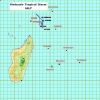
The world economy could be at major crossroads hanging by a thread to abysmal forecasts of gloom to come. From the end of the global economy downturn circa 2008, the rebound has been tremendous and fears of a double-dip were quickly dismissed as the US ploughed on with record levels of job creation and above 2% growth rates. Europe moved on, even though haphazardly as the sovereign debt crisis lingered and unemployment kept on crippling the monetary union. However, this year could be a different story.
As we embarked on the new year 2016, the world economy started showing signs of difficult adjustments. In December last year, the Federal Reserve raised interest rates for the first time since 2006 in a much awaited but dreaded move as the American central bank believed it was time to taper off. The era of cheap money is gone. However, it is unlikely that any other increase will happen in 2016 given prevailing market conditions.
Last week, the Royal Bank of Scotland (RBS) issued a grim report asking its customers to “sell off everything” and find safe haven in Bunds and Treasuries. RBS advised clients to brace for a “cataclysmic year” and a global deflationary crisis, warning that major stock markets could fall by a fifth (20%) and oil may plummet to $16 a barrel. The bank’s credit team said markets are flashing stress alerts akin to the turbulent months before the Lehman crisis in 2008. “Sell everything except high quality bonds. This is about return of capital, not return on capital. In a crowded hall, exit doors are small,” it said in a confidential client note.
Added to that, the International Monetary Fund (IMF) reviewed downwards its economic growth forecast in the January update of its World Economic Outlook (WEO) publication. According to the Fund, advanced economies will see a modest recovery, while emerging markets and developing economies face the new reality of slower growth. Global growth is now expected to reach 3.4% this year and 3.6% in 2017, slightly lower than the forecast issued in October 2015.
“This coming year is going to be a year of great challenges and policymakers should be thinking about short-term resilience and the ways they can bolster it, but also about the longer-term growth prospects,” said Maurice Obstfeld, IMF Economic Counsellor and Director of Research. Growth in advanced economies is projected to rise to 2.1% and to hold steady in 2017, a slightly weaker pick-up than that forecast in October.
“Overall activity remains robust in the United States, supported by still-easy financial conditions and strengthening housing and labour markets. But there are also challenges stemming from the strength of the dollar, which is causing the US manufacturing sector to shrink marginally. In the Euro area, stronger private consumption supported by lower oil prices and easy financial conditions is outweighing a weakening of net exports. Growth in Japan is also expected to firm up in 2016, on the back of fiscal support, lower oil prices, accommodative financial conditions, and rising incomes,” said the IMF report.
Emerging markets face growth slowdown
Emerging market and developing economies are now confronting a new reality of lower growth, with cyclical and structural forces undermining the traditional growth paradigm, as Christine Lagarde pointed out in a recent speech. Growth forecasts for most emerging market and developing economies reveal a slower pick-up than previously predicted. Growth is projected to increase from 4% in 2015 – the lowest rate since the 2008-09 financial crisis – to 4.3 and 4.7% in 2016 and 2017, respectively.
India and parts of emerging Asia are bright spots, projected to grow at a robust pace, whereas Latin America and the Caribbean will again see a contraction in 2016, reflecting the recession in Brazil and economic stress elsewhere in the region. Emerging Europe is expected to grow at a steady pace, albeit with some slowing in 2016, given that Russia could remain in recession in 2016.
The World Bank has on its part, has named its January 2016 Global Economic Prospects report “Spillovers amid Weak Growth” which sets the tone for its findings. The Bank reviewed downwards forecasts for the world economy. “Growth is projected to reach 2.9% in 2016, as a modest recovery in advanced economies continues and activity stabilizes among major commodity exporters,” according to the World Bank’s. Forecasts are subject to substantial downside risks, it added. A more protracted slowdown across large emerging markets could have substantial spillovers to other developing economies, and eventually hold back the recovery in advanced economies.
Along with these risks of spillover, commodity prices have been in freefall since last year. Chinese equities in Shanghai and those in Hong Kong sank as the central bank’s biggest cash injection in the financial system in three years failed to ease concern that the economic slowdown will deepen. Philippine stocks fell to a 23-month low amid a selloff by foreign funds. Price swings in the MSCI Emerging Markets Index were at the highest since October.
Volatility is at a three-month high for Chinese equities amid growing turmoil that has rocked emerging markets as anxiety over the Asian giant’s ability to manage the economic slowdown and slumping oil prices cloud the outlook for global growth. More than $2 trillion has been wiped out from the value of developing nation equities in 2016, the worst ever start to a year.
Hong Kong stocks fell below the value of their net assets for the first time since 1998 as concerns over capital outflows and China’s economic slowdown sent the Hang Seng Index deeper into a bear market. The benchmark gauge slumped 1.8% at the close, pushing its price-to-book ratio below one, a level unseen since the Asian financial crisis of the late 1990’s.
On Thursday, US equity index futures dropped after a rally in Asian stocks reversed, pushing a gauge of global equities back to the brink of a bear market. Benchmark share measures in Tokyo, Shanghai and Manila slumped at least 2.8%, while S&P 500 contracts erased early gains to slide 0.6%. European shares climbed after the region’s stocks plunged the most since August on Wednesday. China’s equities fell despite a drop in money-market rates as the country’s central bank injected the most cash via open-market operations since 2013.
Britain’s stocks rebounded after falling into a bear market as most companies in the FTSE 100 Index rose. The benchmark gauge climbed 0.6 percent at 8:42 am in London after closing on Wednesday at its lowest level since November 2012. Investment managers are warning that markets probably have further to fall as China’s growth slows, oil prices plunge and central bankers lack tools to prop up economies.
The S&P 500 will drop another 10% to 1,650 and oil could fall as low as $20 a barrel as investors flee for safety, according to analysts cited by Bloomberg. Crude sank the most in more than four months as oil executives turned gloomier on the prospect of a recovery this year. Futures fell 6.7% to the lowest since May 2003. Markets could “drown in oversupply,” sending prices even lower as oil demand growth slows and Iran boosts exports, the International Energy Agency said Tuesday.

Notre service WhatsApp. Vous êtes témoins d`un événement d`actualité ou d`une scène insolite? Envoyez-nous vos photos ou vidéos sur le 5 259 82 00 !























